#216 Thick and Fast
Russia, Byju’s, Bank of England Hiking Rates, US-India Technology Cooperation, & Well-intentioned Civil Society Meets the Rigid Indian State
India Policy Watch #1: Riding A Tiger
Insights on issues relevant to India
— RSJ
So many things to write about. Russia, Byju’s and Bank of England hiking rates.
There’s also the fiasco of Adipurush in India. But that can wait for next week, possibly.
Russian Roulette
There’s some kind of a coup unfolding in Russia as I write this. Yevgeny Prigozhin, the boss of the Wagner mercenary group that has been supplying soldiers to Russia in its war against Ukraine, has now turned against the Russian army after weeks of berating it for incompetence on various social media sites. Prigozhin, once the chief caterer of Putin, has, over the years, become a central figure in every conflict that has involved Russia. Syria, Libya, Sudan, Ukraine or social media wars sabotaging elections in the US, France or Germany - there’s a little bit of Prigozhin and his companies, Wagner and the Internet Research Agency (IRA), in all of them. In the last two months, as the Wagner mercenary troops battled hard for control of Bakhmut, Prigozhin got increasingly critical of the Russian military leadership. And on Friday, he released a video saying his forces would blockade Rostov-on-Don unless Defence Minister Sergei Shoigu and Russia’s top general Valery Gerasimov come to meet him. That’s what he has done now. Wagner fighters crossed over from Ukraine into Russia’s Rostov region and have occupied key military installations in its capital of Rostov-on-Don. For Prigozhin, this is a ‘march of justice’ and not a coup. I don’t think Putin has time for such nuances.
Is this the beginning of the end for Putin? A lot will depend on two things. Will some part of the Russian army side with Prigozhin and break away to support Wagner? Will Putin buy time by conceding to a few demands of Prigozhin and then find a long-term fix for Wagner and Prigozhin? If the Russian army splits, even in the smallest of ways, it will be difficult for Putin to wrest control back. A civil war when you are already fighting another war and simultaneously facing global sanctions will be a hole too deep even for Putin to find a way out. The other option of buying temporary peace with Prigozhin might look attractive now. Putin’s strong man image can possibly survive a bloody nose from Ukraine that’s backed by the U.S. military might. But the odds of it remaining intact after being humiliated by his own former chef are quite slim. And once you lose your strong man image, what’s really left of a dictator? So, my guess is Putin has only one viable option now. To assert his supremacy by first warning Prigozhin to back off in strong language and then go all out fighting the Wagner mercenaries. This will be bad for Russia because much of its army isn’t equipped to fight another war, and most of its modest successes in Ukraine were on the back of Wagner. Ukraine will take advantage of this to try and gain back its lost territory and push Russian forces back. If you thought the Ukraine war was an ongoing global uncertainty, wait till this possible scenario unfolds. India has so far managed to use the war to its advantage by buying cheap Russian oil in rupee-denominated trade. Quite a bit of the taming of inflation has been on account of it. Any risk to the Russian energy supply chain will have a real impact on the Indian economy. All economic scenarios will have to be reworked then.
As I write this, Putin has decried ‘betrayal’ without mentioning Prigozhin by name and has vowed to punish those who are fighting the Russian army. No surprises there. He’s been riding a tiger, and now he plans to get off and fight it.
Good luck with that.
Byju’s Education
Talking of riding a tiger, Byju’s and its parent company, Think And Learn (great name), about whom I had written a couple of weeks back, made further news this week.
First, it laid off a further 1000 employees. I’m not sure if anyone working there knows the rationale for these cuts or who is safe from these downsizing moves. It is difficult to imagine the company having a motivated workforce pursuing whatever its goals are at this moment.
Two, the handful of lenders who offered loans to Byju’s customers to buy their expensive long-duration packages have stopped offering credit lines. This availability of a ready loan facility reduced friction in the sales process. In its absence, Byju’s plans to step in and offer direct credit, which is, to put it mildly, a bold move for multiple reasons. For one, it doesn’t have enough capital for running its business, which is why it is laying off people, so how will it lend capital to others? Also, it is not a lending institution that knows how to underwrite loans and collect them. Specialists have lost their shirts doing this. And, lastly, what kind of a business is it where you lend to people to pay you back the same as your revenues? Definitely, not edtech.
Three, news reports suggest that all of the non-executive directors who represented the largest shareholders resigned along with Deloitte, the statutory auditor, on the same day. The shareholder directors resigned because they didn’t seem to be able to exert their influence on how the company was running. It is funny they woke up to this now and not when the company was going along buying an assortment of other edtech companies at expensive valuations that seemed to be done without any diligence or strategic vision. The auditors also seem to have had enough, trying to get the management to help them close books that are now pending for two years. It is better to get out now than when things get worse though I think it is too late even for them to shirk accountability for the mess.
When I wrote about Byju’s a couple of weeks back, I got a few reader messages asking me how does seeking more regulations or government intervention helps things here. I may have been misunderstood. We have a byzantine set of rules that govern the setting up of start-ups, getting foreign investments into them, taxation for those who are investing in them and exiting a venture or an investment. That we still get a lot of inward capital is because we still offer the best potential market opportunity, and there’s nowhere else for the capital to go, really. These have created complex structures where start-ups incorporate themselves outside India and spend inordinate time on tax and local compliance issues that are many and often contradictory among themselves. While on the other hand, we find basic governance lapses in companies that have become large in critical consumer sectors (like education in this case), selling poor quality products and getting away with it only because they are privately held, and their shareholders are looking the other way. It is another case of an inverted structure of regulations in India where tertiary areas that impact the ease of doing business are saddled with all kinds of rules while the fundamentals around governance and consumer protection issues are difficult to enforce. This is what needs to be addressed.
Else, if Byju’s goes into a death spiral, and I sincerely hope it doesn’t, it will make a huge dent for the investment case in India for start-ups and likely reduce the inward capital flow into the private markets that we so keenly need. A good contrast is the continued inward flow into public market stocks that we see largely because of the trust investors have in the regulatory landscape there. Good regulations make a difference. That apart, it will leave a trail of NPAs for a bunch of lenders, a whole lot of dissatisfied customers, disgruntled employees who haven’t been paid their dues and a sector (edtech) that will take a long time to recover. You could argue this creative destruction is an essential part of capitalism. And you could be right. But I would rather have creative destruction happen because a new business model upends the old than companies failing because of hubris and plain old stupidity. Right regulations ensure that society is protected from such risks.
Lots there to think and learn.
Persistence Of Inflation
Inflation isn’t going anywhere in the West as we saw the data from May coming in. It is stuck at 8.7 per cent in the UK, and despite the efforts of the Fed to bring it down, it has been at 4.7 per cent in the US. Core inflation hasn’t moved anywhere since the start of the year. Labour markets remain tight, and wage growth is good despite supply shocks being eliminated. Elevated wages are leading to higher nominal spending that is higher than the production capacity. There isn't a consumption deceleration happening yet. Elevated inflation is now persistent. It is possible that stable state inflation will now be 5-6 per cent unless central banks force the economy to run aground. And they are really trying their best to do that. Here are two news items from the FT in the last week.
First on Bank of England rate hike:
The Bank of England has raised interest rates to 5 per cent, a surprise half-point increase, as the central bank and Prime Minister Rishi Sunak vowed to crush persistent inflation. Andrew Bailey, the BoE governor, was also uncompromising about the need to cut inflation. “We’re not expecting, we’re not desiring a recession, but we will do what is necessary to bring inflation down to target,” he said.
“We know this is hard — many people with mortgages or loans will be understandably worried about what this means for them,” Bailey added.
“But if we don’t raise rates now, it could be worse later. We are committed to returning inflation to the 2 per cent target and will make the decisions necessary to achieve that.”
Next, this statement from Jay Powell:
Jay Powell reiterated his defence of the Federal Reserve’s recent decision to forgo an interest rate rise at a high-stakes congressional hearing on Wednesday, but signalled further tightening as he said the battle against inflation was not over.
The “full effects of monetary restraint” would take time to be realised, Powell said on the first of two days of semi-annual testimony to Congress. He also highlighted that the tightening in credit standards following the collapse of Silicon Valley Bank in March could cause “headwinds” for the world’s largest economy.
Despite staying pat at the latest meeting, Fed officials signalled, in the latest “dot plot” of individual projections, their support for two more quarter-point rate rises this year. And Powell hinted at the time that the first of those could come as early as the next policy gathering in July.
If both increases are implemented, that would ultimately raise the funds rate to 5.5 to 5.75 per cent. No cuts are expected until 2024. Powell on Wednesday said skipping a rate rise while signalling the need for higher borrowing costs was “entirely consistent”.
“The level to which we raise rates is actually a separate question than the speed with which we move,” he said. “Earlier in the process, speed was very important. It is not very important now.” Powell justified the need for further tightening, saying that “inflation pressures continue to run high, and the process of getting inflation back down to 2 per cent has a long way to go”.
The asset prices continue to be higher (stock markets are at near all-time highs), and the central banks are struggling to break the cycle of wage rise, consumption and prices. This won’t change soon because their only tool, interest rate hike, isn’t really working yet. The challenge for India is how much it can decouple from the rate hikes in the rest of the world. A really narrow differential in rates will bring another set of issues for the economy. A real tightrope walk awaits the central bank.
Matsyanyaaya: High-Tech Takes Centre Stage
Big fish eating small fish = Foreign Policy in action
— Pranay Kotasthane
I don’t think any serious policy analyst—even five years ago—would have anticipated that the press briefing of an Indian PM’s Official State Visit to the US would headline concrete actions on high-tech areas such as semiconductors, critical minerals, telecommunications, Space, Quantum Computing, and Artificial Intelligence.
Nevertheless, here we are. Technology is now the centrepiece of the India-US partnership. This technology framework includes strategic technologies, such as jet engine manufacturing in India and space, and also commercial technologies, such as telecommunications, optical fibres, and semiconductors.
How Does it Matter?
Technology occupying the pole position in India-US relations is a big change in the foreign policy outlooks on technology partnerships. Here’s why.
Phase 1.0
After its independence, India interacted with many countries in the West to access advanced industrial technologies. The US specifically assisted India’s nuclear and space programmes, helped develop IIT Kanpur, and contributed to the Green Revolution.
Phase 2.0
But technology became a sore point as the Cold War picked up pace. India faced stringent denial of technology from international regimes in the nuclear and space sectors. The denial of Indian membership into multilateral export control regimes such as the Nuclear Suppliers Group (NSG) and the Missile Technology Control Regime (MTCR) cast a long shadow on India’s foreign policy outlook. The US came to be seen as a technology denier. India’s default stance over the next five decades was to protect its turf in global technological fora while simultaneously developing and shielding domestic capabilities.
This is why the civil nuclear deal in 2005 was such a big deal. It helped India and the US move on from a low-level equilibrium. However, technology still remained a marginal area of cooperation at a time when terrorism and American support for Pakistan gated progress in other sectors.
Phase 3.0
The Modi-Biden Summit is a firm indication that India’s foreign policy outlook on technology has changed. Contributing factors are a growing domestic technological base; an increased presence of Indian talent in the global technology ecosystem; emergent geopolitical realities concerning China; and the rising contribution of crosscutting technologies in national power.
The Indian foreign policy establishment now has a far more positive view of technology and the opportunities it offers for collaboration and competition, apart from contestation. India also realises that technology is now a global enterprise where autarchy is not an option. The contemporary concern is to manage interdependence and make technological supply chains trusted, transparent and resilient. More recently, India’s advances in large-scale digital public infrastructure—payments, identity and data-sharing—give it the confidence to use technology to deepen diplomatic ties.
As for the US, technology has become a primary driver for addressing the China challenge. Nuclear weapons make large-scale conventional conflict unlikely. Similarly, China’s disproportionate role in material supply chains makes any large-scale economic decoupling costly. Consequently, contestation has been in the high-technology domain.
Apart from the denial of technology to China, it has also meant that the US has changed the foreign policy use of technology towards its partners. Cooperation on nuclear-powered submarines under the AUKUS arrangement showed that the US was now willing to share sensitive technologies with partners to counter China. Back then, in the context of India’s dependence on Russia for defence systems, I wrote:
It is thus in the West’s interest to apply this new technology alliance mindset to India. As more options become available, India will find it easier to reduce its dependence on Russia.
It seems this has come true to an extent. The US has been more forthcoming in sharing technology than opening its markets. The FTA with India remains a non-starter, but technology collaboration has grown rapidly.
What does it Imply?
High-tech cooperation is also not as high-stakes as the more contentious areas like trade and the South China Sea. The India-US relationship is so far behind the production possibility frontier on technology, trade and defence that there are enough low-hanging fruits to pick. And that’s exactly what we are seeing now.
In edition #165, I proposed a tri-axis framework to look at the India-US relationship: state-to-state relations, state-to-people relations, and people-to-people relations. There has never been a problem on the people-to-people axis. As the State Visit shows, state-to-state relations have also turned a corner. However, it is the state-to-people axis that is the problematic axis. Many Indians still seem to harbour a deep frustration with the American State. On the other hand, many Americans also have doubts about India as a partner of strategic importance.
Only the two administrations could do something to break this ceiling. By delivering on the asymmetric promises under the technology and defence agreements, the state-to-people axis will finally move on from recollections of the technology denial regime. The announcements are just the beginning; a lot depends on the execution from both sides in these areas.
India Policy Watch #2: The State and the Society
Insights on issues relevant to India
— Pranay Kotasthane
We often discuss the need to harness the strengths of the State, Markets, and Society. Today I will discuss a microstudy at the intersection of society and state action. There’s no definitive lesson here, but it should help you reflect on the role of these two entities.
The story is about Church Street, Bengaluru. It is the best street in the city by a distance. It is a lively business area district street with excellent restaurants, pubs, offices, and bookshops. The footpaths are walkable (hell, yeah!), and the motorway is cobbled. There are no potholes, and it hasn’t been dug up since its current avatar came to life in 2018. On any given day, you will find young folks busy making Insta reels or doing portfolio shoots, with the street serving as a beautiful background. Anyone who knows something about the city would’ve been to Church Street.
It wasn’t always this way. The road was like any other in Bengaluru—pothole-ridden, bikes terrorising pedestrians on footpaths, and a motorway that was perenially under maintenance. The root cause of these troubles was poor contracting. The roads were designed with a perverse incentive of awarding maintenance contracts every year to different utility services. More contracts, more corruption.
That was until Bengaluru’s famous civil society jumped in. A set of committed citizens got into action. They got the government to agree to a new concept called Tender SURE(Specifications for Urban Road Extension), where road standards mandated the integration of utility services under the road—water, sewage, power, fibre cables, gas, and stormwater drains. Committed citizens worked with the local government to see through the execution of this project. A total of ₹17 crore was spent to redesign the 712-metre street. Even the maintenance of the street was assigned to specially-appointed engineers from the TenderSURE project.
Things felt good. Citizen action could resolve the state capacity problems. For a while, it felt that civil society-government interaction of this nature could solve civic problems.
But that was not to be. Look at the image gallery of the street in June 2023. It turns out that the road was to be handed over from the TenderSURE project to the BBMP (the local government) after five years. And as soon as that happened, the maintenance went for a toss. The BBMP ward engineer says they aren’t “aware” that they must maintain Church Street!
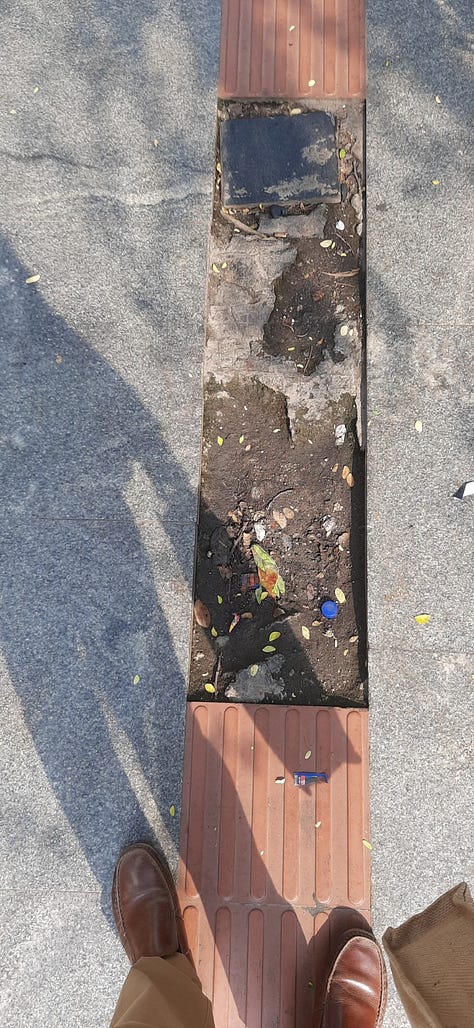
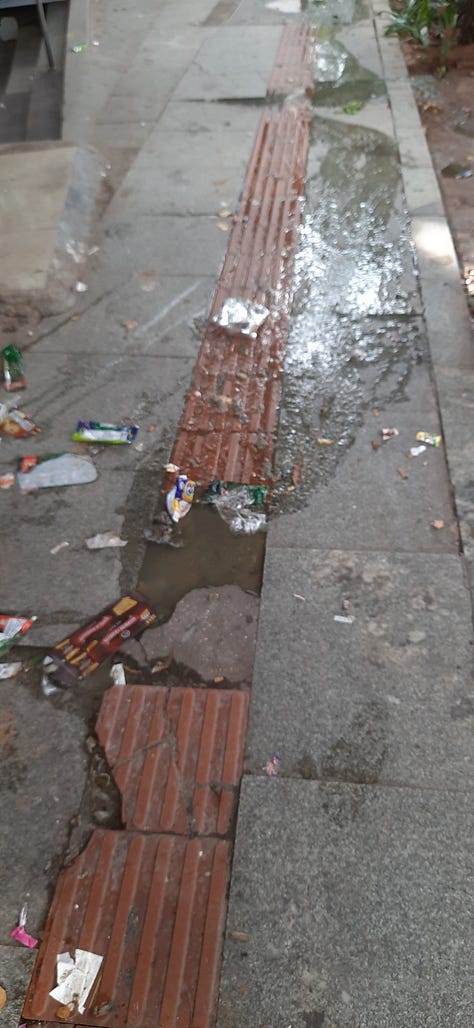
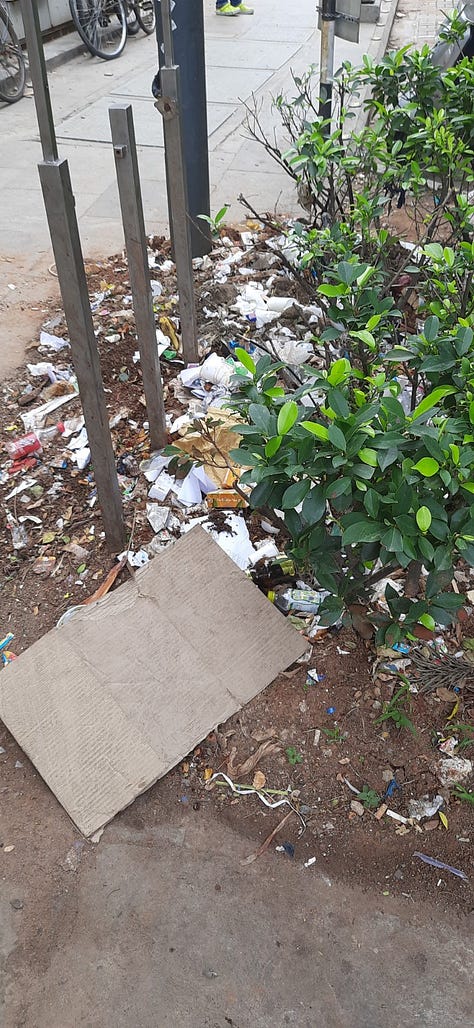

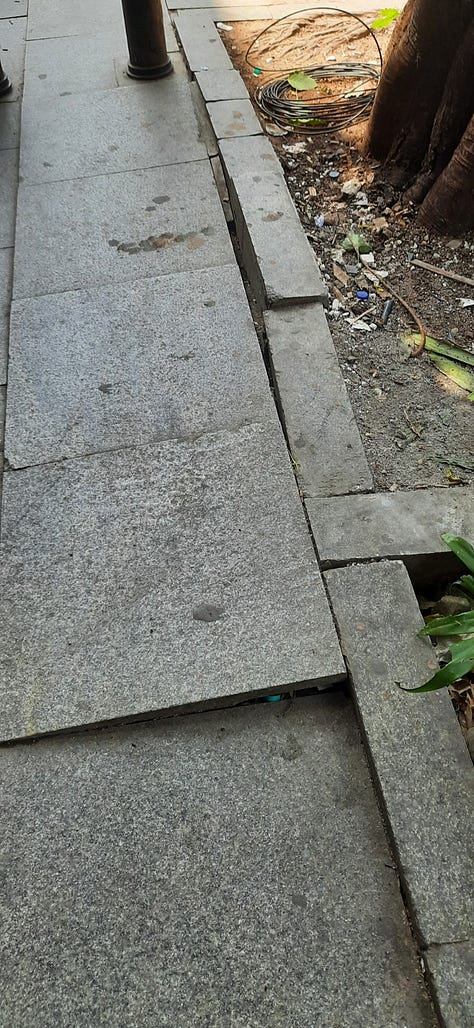
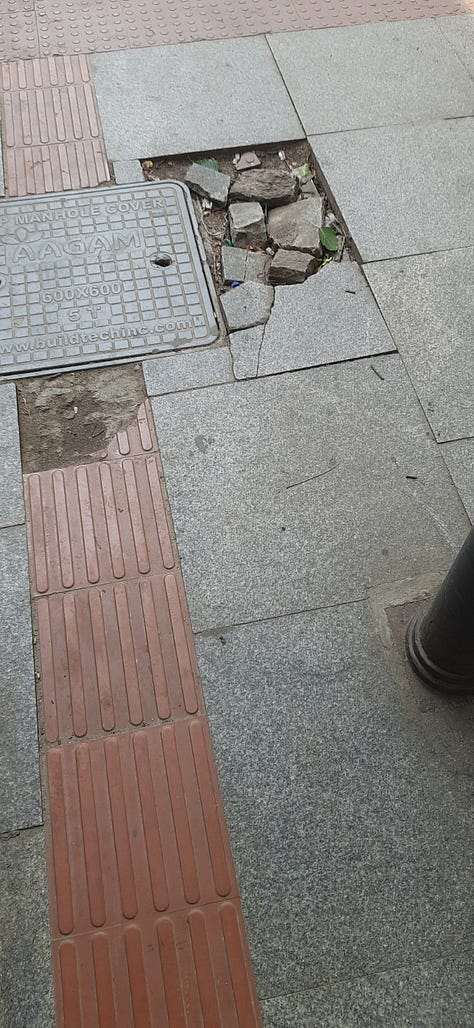
There’re two broader points this situation illustrates.
First, civil society action, however well-intentioned, cannot substitute the State. Ultimately, there is no replacement for building capacity within the government. When society tries to do the state’s job—and does it rather well—the government is only happy to offload the responsibility and the blame to society.
Second, preventing the “tragedy of the commons” is difficult without creating entry barriers. Not every visitor or resident values the common resource enough to care for its good. Elinor Ostrom’s work says that community governance can prevent such situations. In Governing the Commons, she identified a few principles that lond-enduring common pool resources adhere to.
Putting these principles into practice is challenging for hyper-diverse societies to accomplish in a manner that is non-discriminatory and fair to everyone. A lot of our public spaces face this problem.
Do you have any examples where common resources have endured through community action? Please share with us.
HomeWork
Reading and listening recommendations on public policy matters
[Article] C Raja Mohan explains in his Indian Express column how Tech came to be the new driver of India-US diplomacy
[Twitter Thread] In the previous edition, We covered the India-US collaboration on semiconductors. If you are wondering what the Micron chip assembly plant means for India, here’s a background thread.
[Article] On India signing the Artemis Accords and what it means for India’s space exploration plans, read this article by Aditya Ramanathan.
[Podcast] Over at Puliyabaazi, we have a new series called Azaadi Ki Raah. In the first episode, we discuss the Great Trigonometrical Survey of India.




